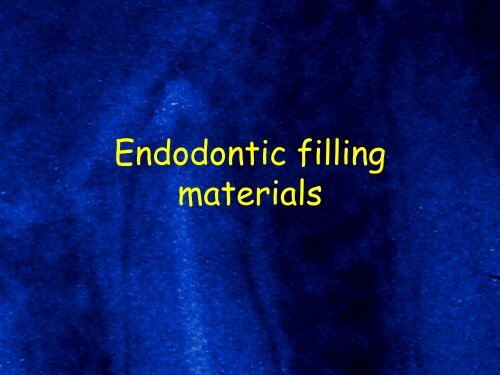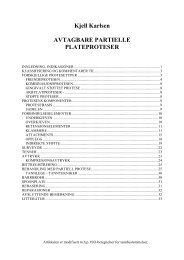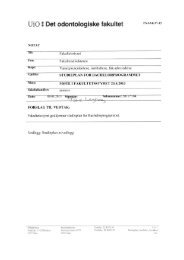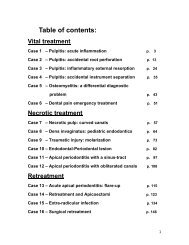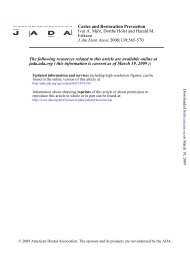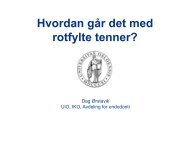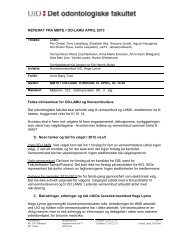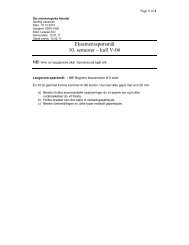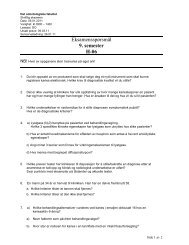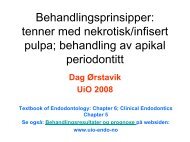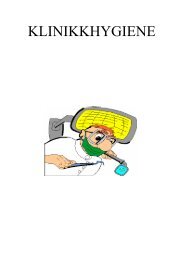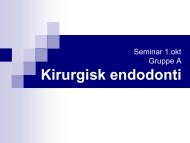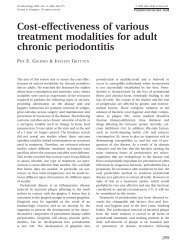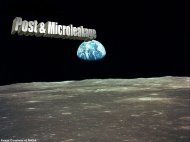Root canal sealers
Root canal sealers
Root canal sealers
Create successful ePaper yourself
Turn your PDF publications into a flip-book with our unique Google optimized e-Paper software.
Endodontic filling<br />
materials
<strong>Root</strong> filling materials<br />
1. Stop coronal leakage<br />
2. Entomb surviving microbes<br />
3. Block influx of water and nutrients<br />
1 2<br />
3<br />
from Sundqvist & Figdor, in ’Essential Endodontology’, 1998
Core Materials<br />
• Gutta-percha<br />
• Metal points<br />
• Plastics<br />
• Combinations
Thermoplasticized gutta-percha:<br />
’hot-warm-soft’<br />
injectable<br />
carriers
’alpha-phase’ versus ’beta-phase’<br />
Alpha-guttapercha is supposedly more fluid<br />
and soften at a lower temperature. Some<br />
sophisticated declarations describe a core<br />
of beta- under a surface of alpha-guttapercha.<br />
Beta phase is made when heated<br />
alpha phase is rapidly cooled to room<br />
temperature. There is little if any<br />
documentation that this distinction is of<br />
importance.
All gutta-percha filling<br />
techniques, including<br />
compaction and other<br />
methods of softening<br />
gutta-percha, always end<br />
up requiring a sealer.
A sealer is what should meet the<br />
hard and soft tissues; the gutta-<br />
percha is merely a piston
Gutta-percha<br />
- adaptability<br />
ZEUG<br />
- dimensionally stable<br />
Silicon<br />
- biocompatible<br />
Chloroform<br />
- adaptability<br />
Chloropercha<br />
- biocompatible<br />
N2 & Endométhasone<br />
- antibacterial<br />
Glassionomer<br />
- why not?<br />
Colophony<br />
- adhesion<br />
Ca(OH) 2<br />
- bio-active<br />
Epoxy<br />
- hardness and adhesion
Endodontic Sealers<br />
• ZnO-eugenol-based<br />
• ZnO-’non-eugenol’-based<br />
• Polymeric cements<br />
• Glass ionomers<br />
• Silicones<br />
• Solvent-based<br />
• Ca(OH) 2 pastes
ZnO-Eugenol-Based<br />
Endodontic Sealers<br />
• Rickert’s sealer ⇒ Kerr PCS<br />
• Grossman’s sealer ⇒ Roth’s,<br />
ProcoSol<br />
• Wach’s paste<br />
• Robin’s paste ⇒ N2, RC2B
ZnO-eugenol-<strong>sealers</strong><br />
•Pro’s<br />
– Used for a century<br />
– Clinical documentation<br />
–Goodseal<br />
• Con’s<br />
– Local toxicity<br />
– Allergen<br />
– Poor stability?
ZnO-’Non-Eugenol’-Based<br />
Endodontic Sealers<br />
• Several proprietary brands<br />
• Poor if any documentation
Glass Ionomer-Based<br />
Endodontic Sealers<br />
•Endion<br />
•Ketac-Endo
Glass-ionomer-<strong>sealers</strong><br />
• Pro’s<br />
– Biocompatible<br />
– Clinical documentation?<br />
• Con’s<br />
– Leakage<br />
–Shrinkage
Glass ionomer sealer<br />
Of 378 followed-up teeth, there<br />
was 78.3% success, 15.6%<br />
incomplete healing, and 6.1%<br />
failure.<br />
Friedman et al., 1995
Polymer-Based<br />
Endodontic Cements<br />
•AH series<br />
•Diaket<br />
• Poly(methyl-methacrylate)<br />
• Resorcinol-formaldehyde<br />
• Composite resins
Epoxy-resin-<strong>sealers</strong><br />
•Pro’s<br />
– More than 40 years<br />
–Clinical<br />
documentation<br />
–Stable<br />
•Con’s<br />
– Toxic when fresh<br />
– Allergen<br />
– Leakage?
RealSeal<br />
Why do we call it RealSeal? Because it is the endodontic filling material that<br />
provides a REAL seal. And Resilon, the primary component of RealSeal, has<br />
also been proven to be biocompatible, nontoxic and nonmutagenic.1 RealSeal<br />
is:<br />
•Leak-Resistant. Unlike gutta percha, RealSeal leaves no gap for leakage.<br />
Coronal and apical leakage are substantially reduced.<br />
•Strengthening. Gives the root significant toughness.<br />
•Technique-Compatible. Works with your current filling method.<br />
•Retreatable. With chloroform and/or heat. Like Grossman’s formula,<br />
retreatments are easy.<br />
•Radiopaque. Just like your current method of obturation, detection is not a<br />
problem.<br />
Company website
”EndoREZ is a UDMA resin-based, root<br />
<strong>canal</strong> sealer with hydrophilic properties that<br />
improve sealing ability even in <strong>canal</strong>s that are<br />
moist with water.This resin-based formula<br />
prevents EndoREZ from compromising<br />
bonding agents. In addition to its<br />
biocompatible, methacrylate formula,<br />
EndoREZ also offers the advantage of<br />
radiopacity. EndoREZ is as radiopaque as<br />
gutta percha, thus simplifying radiographic<br />
interpretation.”<br />
Ultradent, company website
EndoREZ Points<br />
”Resin Coated Gutta Percha Points<br />
EndoREZ Points are standard ISO-sized gutta percha<br />
points overlayed with a thin resin coating. The resin<br />
coating allows EndoREZ Points to bond chemincally<br />
with EndoREZ and other resin-based <strong>sealers</strong>.<br />
Historically, gutta percha has only maintained a<br />
weaker, chemical bond with <strong>canal</strong> <strong>sealers</strong>. EndoREZ<br />
Points are the first-ever gutta percha points to create a<br />
stronger, chemical bond by bonding gutta percha to<br />
EndoREZ.”<br />
Ultradent, company website
Endodontic Sealers<br />
with Ca(OH) 2<br />
•Sealapex<br />
•Apexit<br />
•CRCS
Ca(OH)2-based <strong>sealers</strong><br />
•Pro’s<br />
–20 years<br />
– Clinical documentation<br />
–Goodseal<br />
– Biocompatible<br />
• Con’s<br />
– Unstable?<br />
– Poor x-ray contrast<br />
– Low mechanical<br />
strength
Changes in pH at the dentin surface<br />
in roots obturated with<br />
calcium hydroxide pastes.<br />
12<br />
pH at midroot<br />
surface<br />
11<br />
10<br />
9<br />
8<br />
7<br />
Control<br />
Sealapex<br />
Apexit<br />
Sealer 26<br />
Ca(OH)2<br />
6<br />
0 3 7 14 21 28 45<br />
TIME, days<br />
Esberard RM, Carnes DL Jr, del Rio CE J Endod 1996 Aug;22(8):399-405
Silicone-Based<br />
Endodontic Sealers<br />
•Lee Endofil<br />
•RoekoSeal<br />
• Gutta-Flow
Silicon-based <strong>sealers</strong>
Silicon-based <strong>sealers</strong><br />
•Pro’s<br />
–Verygood<br />
documentation<br />
– Clinically tested<br />
– Biocompatible<br />
• Con’s<br />
– No effect on microbes?<br />
– Poor mechanical strength<br />
– Short history
Picture: M.J.<br />
Roggendorf<br />
Picture: M. J. Roggendorf
Solvent-Based<br />
Endodontic Sealers<br />
• Rosin-chloroform (Johnston-Callahan<br />
technique)<br />
• Chloropercha techniques<br />
• Kloroperka
Solvent-baserte <strong>sealers</strong><br />
• Pro’s<br />
– Biocompatible<br />
– Clinical documentation?<br />
• Con’s<br />
– Leakage<br />
–Shrinkage<br />
No brand shown:<br />
Not to be promoted?
Technological tests
a<br />
b<br />
c<br />
d<br />
e<br />
f
DIMENSIONAL CHANGE, %<br />
6<br />
4<br />
2<br />
0<br />
0 4 8 12 16 20 24 28 32 36 40 44 48<br />
TIME, weeks<br />
AH 26<br />
AH 26 SF<br />
AH Plus<br />
Fig 3a
DIMENSIONAL CHANGE, %<br />
8<br />
6<br />
4<br />
2<br />
0<br />
-2<br />
0 4 8 12 16 20 24 28 32 36 40 44 48<br />
TIME, weeks<br />
Grossman's<br />
Proco-Sol<br />
PCS<br />
Tubli-Seal<br />
Fig 3b
DIMENSIONAL CHANGE, %<br />
1<br />
0<br />
-1<br />
0 4 8 12 16 20 24 28 32 36 40 44 48<br />
TIME, weeks<br />
Roeko-Seal<br />
RS 4823wet<br />
RS 4823dry<br />
Fig 3c
DIMENSIONAL CHANGE, %<br />
1<br />
0,5<br />
0<br />
-0,5<br />
-1<br />
-1,5<br />
0 4 8 12 16 20 24 28 32 36 40 44 48<br />
TIME, weeks<br />
Apexit<br />
Apexit H2O<br />
Ketac-Endo<br />
Fig 3d
0<br />
Hoop stress -<br />
(tension)<br />
Radial stress -<br />
(pressure)<br />
1 mm<br />
3 mm
100<br />
Tangential stress [MPa]<br />
10<br />
1<br />
0,1<br />
0,01<br />
0,001<br />
Composite<br />
Elastomer<br />
0 0,2 0,4 0,6 0,8 1<br />
Linear expansion of material [%]
Physical properties of endodontic<br />
<strong>sealers</strong>: radio-opacity, working time,<br />
flow and compressive strength<br />
measurements<br />
Ayce Unverdi Eldeniz<br />
Guest Researcher, Scandinavian Institute of Dental<br />
Materials, Haslum, Norway<br />
Dag Ørstavik<br />
Oslo University, Faculty of Dentistry, Head of the<br />
Department of Endodontics, Oslo, and the Scandinavian<br />
Institute of Dental Materials, Haslum, Norway
<strong>Root</strong> <strong>canal</strong> <strong>sealers</strong> tested:<br />
AH Plus<br />
Component A<br />
Epoxy resin<br />
Calcium tungstate<br />
Zirconium oxide<br />
Aerosil<br />
Iron oxide<br />
Component B<br />
Adamantane amine<br />
N,N-Dibenzyl-5-oxanonane<br />
TCD-Diamine<br />
Calcium tungstate<br />
Zirconium oxide<br />
Aerosil<br />
Silicone oil
<strong>Root</strong> <strong>canal</strong> <strong>sealers</strong> tested:<br />
GuttaFlow<br />
Gutta-percha powder<br />
Polydimethylsiloxane<br />
Silicone oil<br />
Paraffin oil<br />
Hexachloroplatinic acid<br />
Zirconium oxide<br />
Nano-silver<br />
(preservative)
<strong>Root</strong> <strong>canal</strong> <strong>sealers</strong> tested:<br />
AcroSeal<br />
Calcium hydroxide<br />
DGEBA<br />
Radiopaque excipient<br />
Glycyrrhetic acid<br />
(enoxolone)<br />
Methenamine<br />
Radiopaque excipient
<strong>Root</strong> <strong>canal</strong> <strong>sealers</strong> tested:<br />
EndoRez<br />
30% Urethane dimethacrylate
<strong>Root</strong> <strong>canal</strong> <strong>sealers</strong> tested:<br />
Epiphany<br />
Dual-cure, urethane-based<br />
dental composite cement
12,0<br />
10,0<br />
8,0<br />
6,0<br />
4,0<br />
2,0<br />
0,0<br />
<strong>Root</strong> <strong>canal</strong> <strong>sealers</strong>’<br />
radiopacity<br />
Radiopacity (n=3)<br />
Endo-REZ<br />
Epiphany<br />
RC Sealer<br />
Roeko Seal<br />
Gutta Flow<br />
Apexit<br />
Acroseal<br />
AH Plus
<strong>Root</strong> <strong>canal</strong> <strong>sealers</strong>’ film<br />
thickness<br />
Film Thickness (n=15)<br />
50<br />
45<br />
40<br />
35<br />
30<br />
25<br />
20<br />
15<br />
10<br />
5<br />
0<br />
AH Plus<br />
Endo-REZ<br />
Epiphany<br />
RC Sealer<br />
Roeko Seal<br />
Gutta Flow<br />
Apexit<br />
Acroseal
<strong>Root</strong> <strong>canal</strong> <strong>sealers</strong>’ flow<br />
Flow (n=15)<br />
50<br />
45<br />
40<br />
35<br />
30<br />
25<br />
20<br />
15<br />
10<br />
5<br />
0<br />
AH Plus<br />
Endo-REZ<br />
Epiphany<br />
RC Sealer<br />
Roeko Seal<br />
Gutta Flow<br />
Apexit<br />
Acroseal
<strong>Root</strong> <strong>canal</strong> <strong>sealers</strong>’<br />
compressive strength<br />
Compressive strength (Mpa) by time (h)<br />
400<br />
350<br />
300<br />
250<br />
200<br />
150<br />
100<br />
50<br />
0<br />
0 50 100 150 200<br />
?<br />
AH Plus<br />
Endo-REZ<br />
Epiphany<br />
Apexit<br />
Acroseal
Smear layer removal<br />
• Opens tubules for<br />
medicament<br />
activity<br />
• Removes (infected)<br />
smear and<br />
substrate for<br />
microbial growth<br />
• Allows permeation<br />
of filling material<br />
• Shows little effect<br />
on adhesion of<br />
filling<br />
• Penetration by<br />
bacteria may be<br />
enhanced:<br />
– Between sessions<br />
– After filling
Gr.<br />
1,20<br />
1,00<br />
0,80<br />
0,60<br />
0,40<br />
0,20<br />
0,00<br />
Native<br />
Phosph. Acid<br />
Citric acid<br />
EDTA<br />
Gr.<br />
APX<br />
KE<br />
AH Plus<br />
RS+P<br />
RS<br />
APX<br />
KE<br />
RS<br />
RS+P<br />
AH Plus<br />
Saleh et al., 2001:<br />
Adhesion of<br />
root <strong>canal</strong> <strong>sealers</strong><br />
to pretreated dentin
Antimicrobial<br />
activity<br />
• Toxic chemicals<br />
– disinfectants<br />
– antiseptics<br />
• Antibiotics
Iodine-containing gutta-percha<br />
(Lone Star)
Current antimicrobial<br />
additions<br />
•Formaldehyde<br />
•Eugenol<br />
•Thymoliodide<br />
•Amines<br />
• Calcium hydroxide
Clinical biocompatibility<br />
• Local<br />
•Regional<br />
• Systemic<br />
Severity<br />
Frequency
PN Liston, RF Walters<br />
Foreign bodies in the maxillary antrum: A case report<br />
Australian Dental Journal 2002;47(4):344-346
14d<br />
AH-materials give a strong<br />
reaction after 14d, but show little<br />
effect on tissues after 3 months<br />
3 months<br />
14d
Sealapex: Induction of hard<br />
tissue formation<br />
7<br />
6<br />
5<br />
4<br />
3<br />
2<br />
1<br />
Closure<br />
Partial closure<br />
No closure<br />
Inflammation<br />
0<br />
Sealapex<br />
Kerr PCS<br />
Holland & de Sousa 1985
Periapical reactions to<br />
<strong>sealers</strong> in monkeys<br />
8<br />
7<br />
6<br />
5<br />
4<br />
3<br />
2<br />
1<br />
0<br />
Sealapex CRCS AH26<br />
None<br />
Mild to moderate<br />
Severe<br />
27 teeth in 3 monkeys, 8-14 months<br />
Tagger & Tagger 1985
Allergy<br />
• (Almost) All endo materials contain<br />
allergens<br />
• The exposure to sensitive tissues is<br />
extremely small<br />
• Exposure to skin, mucosal surfaces of<br />
patients and the skin of staff may<br />
deserve more attention
Mutagenicity - Carcinogenicity<br />
• Mutagenicity– the ability to cause<br />
changes in the genes of an individual<br />
• Carcinogenicity– the ability to cause<br />
cancer in an individual<br />
• 70-90% of mutagens are carcinogens<br />
and vice versa
In vitro model for coronal leakage<br />
Upper chamber<br />
with bacteria<br />
Sterilised, root<br />
filled root<br />
Barthel et al, 1999<br />
Wax seal<br />
Lower chamber, sterile<br />
medium<br />
Bacteria penetrating the root filling multiply in the clear<br />
medium of the lower chamber, making it turbid.
% Microbial leakage over 30 days<br />
100<br />
90<br />
80<br />
70<br />
60<br />
50<br />
40<br />
30<br />
20<br />
10<br />
0<br />
S. mutans<br />
E. faecalis<br />
S. mutans and<br />
E. faecalis<br />
% of microbial leakage<br />
V GP - Epiphany sealer<br />
L GP - Epiphany sealer<br />
V GP - AH26 sealer<br />
L GP - AH26 sealer<br />
V Resilon - Epiphany sealer<br />
L Resilon - Epiphany sealer<br />
V Resilon - Epiphany sealer<br />
L Resilon - Epiphany sealer<br />
Negative Control<br />
Positive Control - GP<br />
Positive Control - Resilon<br />
Groups<br />
Epiphany –<br />
’an appearance or manifestation especially of a divine being’
Bacterial leakage<br />
100<br />
80<br />
60<br />
40<br />
20<br />
0<br />
Leaking teeth, %<br />
•AH Plus<br />
•EndoRez<br />
•RC Sealer<br />
•Roeko-Seal<br />
•Ketac-Endo<br />
•Acroseal<br />
•Apexit<br />
•Gutta-Flow<br />
•Epiphany
Bacterial leakage<br />
• AH Plus 15/15<br />
• EndoRez 15/15<br />
• RC Sealer 15/15<br />
• Epiphany 4/15<br />
• Acroseal 9/15<br />
• Apexit 5/15<br />
• Roeko-Seal 5/15<br />
• Gutta-Flow 5/15<br />
• Ketac-Endo 14/15
Saleh et al. 2003<br />
5<br />
Mean Log CFU<br />
4<br />
3<br />
2<br />
1<br />
0<br />
-1<br />
CT KE RSP AP RS CH GS AH<br />
CT KE RSP AP RS CH GS AH<br />
Sealer<br />
(CT: control; KE: Ketac-Endo; RSP: RoekoSeal Automix + Primer; AP:<br />
Apexit; RS: RoekoSeal Automix; CH: Calcium Hydroxide; GS:<br />
Grossman’s sealer; AH: AH Plus)
Clinical/Radiographic Follow-<br />
•Pain<br />
Ups<br />
• Success-failure<br />
analyses<br />
• Disease – no disease<br />
•Sizeoflesion<br />
• Periapical index<br />
• Computer technology
Time-course of postoperative pain following<br />
root filling with either Roeko Seal or<br />
Grossman’s sealer. Average values<br />
6<br />
Relative pain intensity, %<br />
4<br />
2<br />
Roeko Seal<br />
Grossman<br />
0<br />
D1S D1Be D2Br D2L D2S D2Be D3Br D3L D3S D3Be<br />
Coefficient of variation: 118-400%
EndoREZ<br />
Am J Dent. 2004 Feb;17(1):19-22.<br />
Clinical and radiographic evaluation of a resin-based<br />
root <strong>canal</strong> sealer.<br />
Zmener O, Pameijer CH
Clinical Study – EndoRez<br />
100<br />
90<br />
80<br />
70<br />
60<br />
50<br />
40<br />
30<br />
20<br />
10<br />
0<br />
91,3 89,1<br />
92,2<br />
All teeth CAP NAP<br />
'Success'<br />
’Feasibility study’
Cumulative PAI Scores<br />
AH KP PS<br />
0 1 2 3 4<br />
0 1 2 3 4<br />
0 1 2 3 4<br />
TIME: 0 to 4 years
Clinical Evaluation<br />
•Prevention<br />
– failure: AP developing where none<br />
existed<br />
– AH26 vs ProcoSol (Grossman’s sealer) vs<br />
Kloroperka: Significantly poorer results<br />
for Kloroperka in one clinical study
Healing of apical periodontitis following<br />
root filling with 3 different <strong>sealers</strong><br />
PERIAPICAL STATUS, ridit<br />
0,5<br />
0,4<br />
0,3<br />
0,2<br />
0 1 2 3<br />
Total<br />
ProcoSol<br />
Sealapex<br />
CRCS<br />
TIME, years<br />
Range of s.e. of means: 0.02-0.07
Preoperative Healthy Periodontium:<br />
Effect of Sealer<br />
PERIAPICAL STATUS,<br />
ridit<br />
0,3<br />
0,2<br />
0,1<br />
0<br />
0 1 2 3<br />
TIME, years<br />
Total<br />
ProcoSol<br />
Sealapex<br />
CRCS<br />
Range of s.e. of means: 0.03-0.17
X-ray<br />
healing<br />
AP<br />
N<br />
AP<br />
N<br />
Digital<br />
change<br />
AP/N < 1 AP/N ≅ 1
Numbers are average gray values in the<br />
defined areas: 255=white; 0=black<br />
130<br />
130<br />
80<br />
115<br />
Digital<br />
change<br />
AP/N =0,62 AP/N 0,88
AP/N<br />
1,2<br />
Sound<br />
Diseased<br />
1<br />
0,8<br />
0,6<br />
0 4 8 12 16 20 24<br />
TIME, months
From Trope et al., 1998
Healing by AP/N Ratio<br />
PA Status, P/N ratio<br />
80<br />
60<br />
40<br />
0 5 10 15 20 25<br />
TIME, weeks<br />
PS<br />
SA
Healing by PAI Score<br />
PA Status, PAI ridit<br />
1<br />
0,8<br />
0,6<br />
0,4<br />
0 5 10 15 20 25<br />
TIME, weeks<br />
PS<br />
SA
Comparative clinical testing<br />
• ProcoSol, Grossman’s sealer:<br />
REFERENCE<br />
– AH26: as good or better<br />
– Sealapex: as good or better<br />
– CRCS: no worse<br />
– RoekoSeal no worse<br />
– Kloroperka poorer<br />
– Epiphany as good or better
Healed cases, per cent<br />
100<br />
Prospective study of factors related to<br />
healing of AP<br />
90<br />
80<br />
70<br />
60<br />
Preop<br />
AP<br />
No<br />
preop<br />
AP<br />
Warm<br />
vertical<br />
Cold<br />
lateral<br />
Cliinical variables<br />
Single<br />
root<br />
2+ roots<br />
Farzaneh et<br />
al.<br />
JOE April<br />
2003, OR 45<br />
The Toronto<br />
study:<br />
outcome of<br />
initial<br />
endodontic<br />
treatment -<br />
phase II
New methods for filling root <strong>canal</strong>s<br />
must be viewed with regard to<br />
their ability to aid in achieving the<br />
prevention of new or persistent<br />
apical periodontitis; the acid test<br />
being roots with preoperative<br />
apical periodontitis
’Predictable disinfection’: how<br />
much can we improve?<br />
• instrumentation 90/10* 95/20<br />
• irrigation 99/50 99,9/95<br />
• ‘medication’ 99,9/95 99.99/98<br />
• <strong>Root</strong> filling 100/100?
Predictable disinfection<br />
1. Complete physical and<br />
chemical disinfection in one<br />
session?<br />
(’Dauerantisepticum’, CHX?)<br />
2. Prevention of regrowth<br />
(antibacterial sealer?)<br />
3. Block influx of nutrients<br />
(improved seal?)<br />
AP<br />
P<br />
PDL
’Predictable disinfection’: can<br />
we improve?<br />
Standard methods<br />
Improvement?<br />
Microbes Canals Microbes Canals<br />
• instrumentation 90 10 95 50<br />
• irrigation 99 50 99,9 95<br />
• dressing 99,9 95 99.99 98<br />
• <strong>Root</strong> filling 100 100?<br />
Thank you for your attention!


